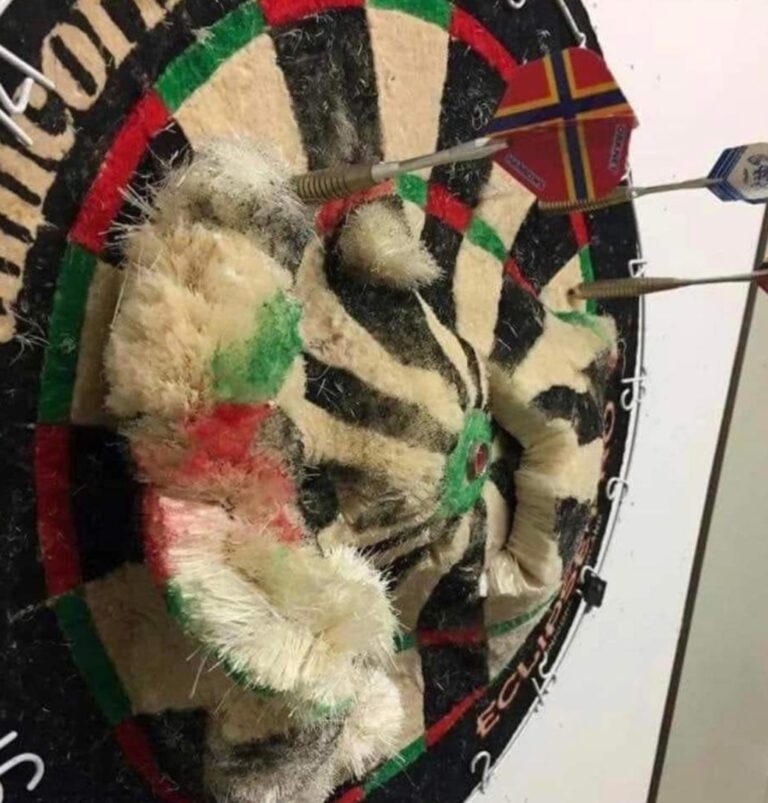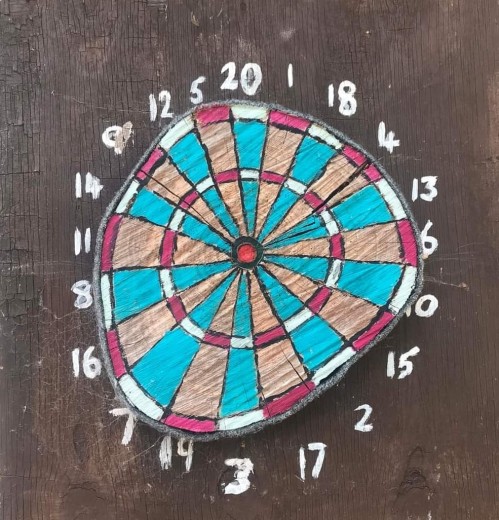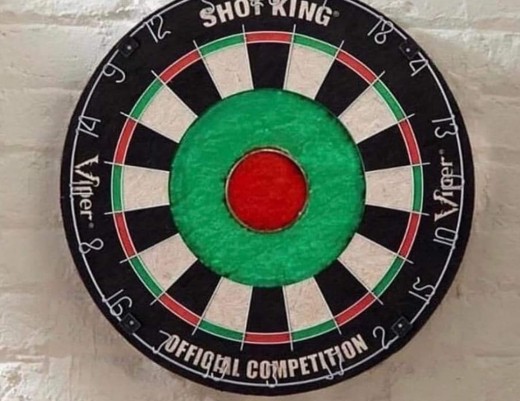May 1, 2007
Column 291
The Iditarod Open
I am we todd did. I am we todd did.
I am sofa-king we todd did.
— Old Eskimo darters saying
Iditarod or “I. Dartoid” – that is the question.
Anagrams have always fascinated me…
But the discovery by my wife that my pen name is buried inside of the name of the Last Great Race on Earth, the 1,150-mile Anchorage to Nome dog-sled trek across the frozen wilds of Alaska, flat-out blows my mind.
Some say anagrams reveal deep truths. The same goes for the sometimes uncanny wisdom of our elders.
But I say (and you can take this to the bank), while the old Eskimo saying above was predictive of my experience at the 21st Annual $10,000 Iditarod Dart Tournament, the anagram was, is, and forever will be unequivocally wrong. Since returning to sunny civilization, I’ve talked at length with my golden retriever and we’re agreed: there ain’t no frickin’ way that you’re gonna see our Florida asses join a team of huskies to spend two weeks being chased across glaciers by killer Bullwinkles in a negative fifty degree blizzard. Not never, ever.
What I will do, one of these days, soon I hope, is return to the Great White North to follow the amazing Iditarod and throw darts in another Iditarod Open. I will do this out of respect for the wisdom of the old Eskimo darters who somehow knew that after a dozen beers my condition would be such that I would delight in vigorously rubbing the oosik mounted on the wall and then stupidly close tops when I needed thirty-two to move into the final eight in cricket. We todd did! We todd did!
And please, don’t ask me what an oosik is! If you’ve gotta know (and I warn you in advance – you don’t want to know) go here: http://en.wikipedia.org/wiki/Oosik. Don’t say I didn’t warn you…
To say that this trip was a long haul is an understatement. Let me put it in perspective. The 5,900-mile distance from Tampa to Nome is about the same as the distance from London to Shanghai or Johannesburg.
Now, let me ask you this – yes YOU, Mr. hot-shot British darts person: when was the last time you booked a flight to travel almost 6,000 miles across your own country to throw in a tournament? It’s been a while, eh mate? Damn right it has. You could frickin’ walk across England in the time it took me to get to Alaska.
So crikey, think about this next time you criticize us Americans for not getting out on the circuit as often as you blokes do. Give us a bloody break.
I stopped over in Anchorage for a night and it’s a good thing I left quickly as I somehow managed to lose my coat and cell phone and be refused service in an upstanding establishment, aptly called the Great Alaskan Bush Company, where I was dragged through the door against my will. If you are over eighteen years of age and not offended by women wearing NOTHING, go here: http://www.akbushcompany.com/.
My initial guides for my Anchorage adventure were Jerry “Big” Cooper, Sean Totzke, and Jeff Olson. Olson is the American Darts Organization’s (ADO) regional director for Alaska which means he is famous and extremely important, even though he wasn’t able to get me a waiver to shoot in the ADO Regional on Friday (which he won). So I was forced to beat him in cricket on Sunday!
I was taken to three Anchorage darts bars: PJ’s, the Hideaway, and Club Oasis, all worth a stop if you’re ever in the area. It was at the Oasis that I met Steve “Dick Wheat” Mangiapane, my guide for the rest of the night and for years the best shot in Alaska. I don’t know why they call him Dick Wheat and it probably doesn’t matter. As I understood his nickname to be “Dickweed,” this is what I called him all night – so he’ll probably never want to see me again anyway. He was kind enough (or perhaps it was payback) to give me a copy of James Michener’s tome, Alaska, which I’ll be sure to read sometime when I have two or three years to spare.
In the morning I headed to Nome in the back of a converted cargo plane with Big, Olson and his sexy wife Michele, and several other people wearing actual freezing cold weather gear much like the coat I lost. From my window I snapped a photograph of Mt. McKinley – at 20,320 feet, the tallest mountain in North America – and marveled at the courage and athleticism of the mushers and their teams of dogs so far below, slogging their way through the elements towards Nome and the famous burled arch Iditarod finish line.
They say – and they are right – that if you doubt hell freezes over you’ve never been to Nome. The night before I arrived, the mercury actually did register minus fifty degrees. Despite finding a jacket, gloves, hat and carrying around a portable heater I shivered my way through the entire weekend. The tournament venue – a club called the Alaska Native Brotherhood (ANB) – was little more than a block from my hotel, but not once did I even consider foregoing a taxi.
Nome is also remote. Nestled along the Bering Sea to the west, just a thirty minute flight from Russia and about an hour south of Kotzebue and the Arctic Circle, there are only three roads leading in and out of town – to the east, north, and south – and none of them stretch for more than seventy-five miles. They just stop. “Why?” I asked one of the local darters, Becky Eckerman. “Where is there to go?” was her simple reply. Eckerman, formerly from Ohio and now a nurse at the local hospital, traveled the circuit for years. Seeing her name here will certainly bring back old memories for people like Steve Brown and Marilyn Popp.
On a clear night, which I was not fortunate to experience, the aurora borealis, or northern lights, shimmer and dance spectacularly in the huge northern sky. One can’t help but conjure images of what it must have been like centuries ago when woolly mammoths walked the tundra.
Somewhere in the icy distance moose, caribou, reindeer, musk oxen, and grizzlies forage. Further off there are polar bears and herds of bison. Under the pack ice to the west whales, walruses, and seals slice through the frigid water.
There are four ways to get to Nome and none of them is by car. From the west one can arrive by ship. Otherwise the options are by plane, snowmobile, or dog sled. Several shooters at the tournament arrived by snowmobile from tribal villages many hours away.
In 1925 when a diphtheria epidemic threatened the survival of the Nome community it was mushers and sled dogs that relayed the antitoxin 674 miles in five and a half days to save the small city. It is this “serum run” that the modern day Iditarod commemorates and events like the Iditarod Dart Tournament are many during the Iditarod race.
By the time I arrived in Anchorage the mushers – some 100 teams of as many as sixteen dogs – had already departed and the leaders were pulling out of Finger Lake (population: two!) on the fringe of the Alaska Range. The race record of just shy of nine days, established by Martin Buser in 2002, suggested the possibility that I might just get the chance to be among the welcoming crowd when this year’s winner arrived.
Darts is done differently in Alaska, at least at the Iditarod Open, and I like it! Rather than place darters into brackets at the start of each event, long-time Tournament Director Warren Little first divided the entrants into groups that competed in a round-robin format to earn their place for the draw into a straight knockout and the final sixteen stage. Hence, as can commonly occur, a tough draw in the first or second round does not immediately send a player to the bar stool. For someone like me who once drew Luis Martinez twice in first rounds at the old North American Open it was a pleasure to get my money’s worth for my entry fees in Nome.
As the lead mushers and their teams were arriving in McGrath (population: 423) at the confluence of the Kuskokwim and Takotna rivers, I stepped to the line for mixed triples with Eckerman and another local shooter, Willie Hoogendorn. We made it out of our group but saw our run end in the top sixteen. I then arranged to throw doubles the next morning with Hoogendorn’s brother, Steve, and packed it in for the night, hopping into a cab for the twenty second ride to my hotel.
As it turned out I should not have done this because I missed one of the two highlights of the tournament – a friendly wrestling match between Jeff Olson and a darter from Juneau, Phil “Phildo” Wheeler, wherein Wheeler was knocked unconscious. Wheeler, a character-and-a-half and a great shot (he won cricket on Sunday in a terrific match against Derk Inga from Anchorage), would have given the late Bucky Bakalac a run for his money in both departments. Depending on the moment he was dressed as either Flavor Flav, threatening to don a thong made from duct tape, or thrusting a stuffed oosik in places no oosik should ever be found.
The good news is that, at least for the minute or so that Phildo was knocked out, he was quiet.
The second highlight of the tournament occurred on Sunday in doubles 501. Carl “the Mongolian Meat Puppet” Merchant and Jason Eimer were playing Merchant’s brother, Bill, and Larry Clark – and were looking down the barrel of certain disaster. Back-to-back maximums by the later pair inspired an early victory celebration. Not a sole in the joint was unaware that the two were a handful away from a perfect game. Unfortunately, not only did the perfect game escape – so did victory. Despite the spectacular start by their opponents, the Meat Puppet and Eimer walked away with the win. Of course, this didn’t stop Bill Merchant from ripping the scoreboard from the wall to keep as a memento of the occasion.
As the tournament drew to a close late on Sunday, and as a battle seemed to loom among three or four of the dog-sled teams, now near White Mountain (population: 203), I found myself in an astonishing conversation with Teresa Beckwith, Derk Inga’s significant other. Beckwith works for Federal Express and a few years ago spent time in Hong Kong. Before heading overseas she sent out some e-mails and connected with someone from the Hong Kong Dart Association, namely Noel Li, who upon Beckwith’s arrival showered her with hospitality and showed her around the darts scene. The astonishing thing is that I know Noel Li and I know her well. We have thrown darts together in the Philippines and will probably go out in Hong Kong this June. That two people who live 6,000 miles apart in the United States could meet, literally in different worlds, and discover that they have a friend in common in yet another world, thousands more miles away, is just another reminder of how truly small – and friendly – the wonderful community of darts really is.
I was told that it was a novelty for someone from the “lower forty-eight” to travel to throw darts in Nome – that only Wade Wilcox had preceded me in the twenty-one history of the tournament. Darter Ken Waterman told me that Gerald and Lori Verrier ventured to Anchorage a time or two. And good old Steve Mangiapane, who showed me around Anchorage on Monday before my return flight to my home away from Nome, took me by the Pioneer Bar where John Lowe was once spotted tearing up the sisal.
I departed Nome just before noon on Monday and arrived back in the Sunshine State about dinner time on Tuesday. I didn’t need the coat I didn’t have. I immediately stopped service on my cell phone and arranged for a new one.
Six hours later and a half a world away, but still in this amazing land called America, thousands of fans lined the street in front the Nugget Inn, the hotel I’d just left in Nome.
As the sun slowly set over the glimmering pack ice, a murmur arose as into view just to the north appeared Larry, the indomitable lead dog of thirty-six year old cancer survivor, Lance Mackey, from Fairbanks.
Minutes later at 8:08 p.m. – nine days, five hours and 1,150 miles after setting off from Anchorage – the crowd exploded in applause as Mackey and his team crossed under the burled arch to claim victory (in the third fastest time ever) in the thirty-fifth Last Great Race on Earth, the Iditarod.
At home in Florida it felt odd, lonely in one way and just plain wrong in another, to be missing the conclusion of the event that permeated every moment of my Alaskan darts experience. I’d literally traveled 12,000 miles and missed the final glorious moment.
A week later my doorbell rang and there stood a man from Federal Express. In a small box, tightly packed with dry ice, I found a selection of smoked salmon sent by one of the many new friends I made on my trip – darter Scott Perkins from Juneau.
The next morning I returned the gesture by arranging for a shipment of grapefruit.
And I made the commitment to return to the Great White North, perhaps as soon as next year, to get we todd did all over again, maybe even kiss the oosik, throw more darts, and stand shivering with the welcoming crowd to celebrate the Last Great Race on Earth.
From the Field,
I. Dartoid








